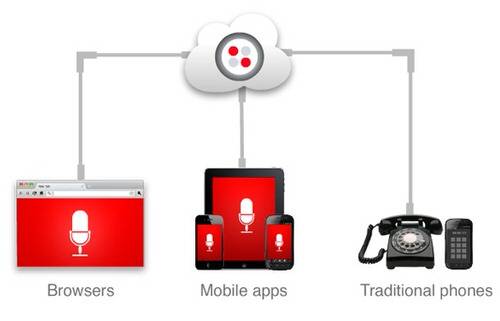Imagine playing a game of Scrabble on your iPhone against your mother. You and Ma are competitive and these games tend to turn into rabid battles for literary supremacy. Also, she’s your mother so you want to talk about how things are with the family, your nephew and if Pa is taking that new job in Chicago. So, you press a button in the app and create a voice connection running over your data connection. No dialing, no minutes used. Just a data connection straight from the app.

Cloud communications company Twilio is making that possible. Today it is announcing a new native iOS software developer kit for its Twilio Client, allowing voice-over-IP calls from any app. The future of telephony is in data connections, not wireless minutes and Twilio is looking to make the mobile carriers’ networks programmable for the next generation of app developers.
The Twilio Client iOS SDK is an extension of the browser-based SDK the company announced in 2011. The idea is to create a voice connection from any app, anywhere. Think of it as the smart device version of a walkie-talkie. It is a fairly simple but powerful idea.
We wrote about Twilio’s ability to disrupt the mobile carriers in January and the basic tenets hold true – when communications become IP based, the business model has to change. Twilio is just nudging the carriers in that direction. Yet, instead of outright disrupting the carriers, Twilio thinks that it can become a partner. The idea is to create value for the cellular network.

“I actually think we would be interested in a partnership opportunity with the carriers. I think something like Skype would be in competition with the carriers because they are going after the end users,” said Thomas Schiavone, Twilio’s project manager responsible for the iOS SDK. “We are an API on top of networks. The carriers have the opportunity to work with developers and add value to the networks, which is something that they need to do. We are trying to figure out how to give people an API that adds value to the network and new and interesting use cases as opposed to the traditional, ‘I want to call someone.'”
Unlike other companies that provide programmable VoIP solutions, Twilio does not institute a threshold to use its services. There are no minimum messages that need to be sent per month, no amount of minutes or data that a developer needs to hit to use the Twilio Client. The idea is to create ubiquity across the developer landscape as opposed to an artificially high limit that precludes smaller developers from adding an interesting feature like push-to-call in their apps.
From an enterprise standpoint, Twilio can add a lot of value to a single employee out of the office. The logic needed to create a call center is located in the Twilio cloud and accessible through its variety of SDKs. Since it creates a data connection, all an employee would need to become a IP PBX call center is an iPad and the proper software.
“What we really think is interesting is that it can run the gamut between consumers and enterprise; how do I improve my business practices?” Schiavone said. “All that logic is internal to Twilio. You can think of the Twilio Client as sort of the end-user experience that you present to the user and all the smarts and intelligence are not in the SDK. All the brains and smarts are in the Twilio cloud.”
Twilio has an Android SDK in beta that developers can sign up for. The company will continue to evolve the Twilio client, giving it more robust features.
“You will see continued investment in this Twilio Client with Web calls, IP next-gen infrastructure because I think there is a lot of value we can give to developers and in extension, to users,” Schiavone said.
What do you think about the “programmable network?” Is a voice connection something you need in your app? Let us know in the comments.









